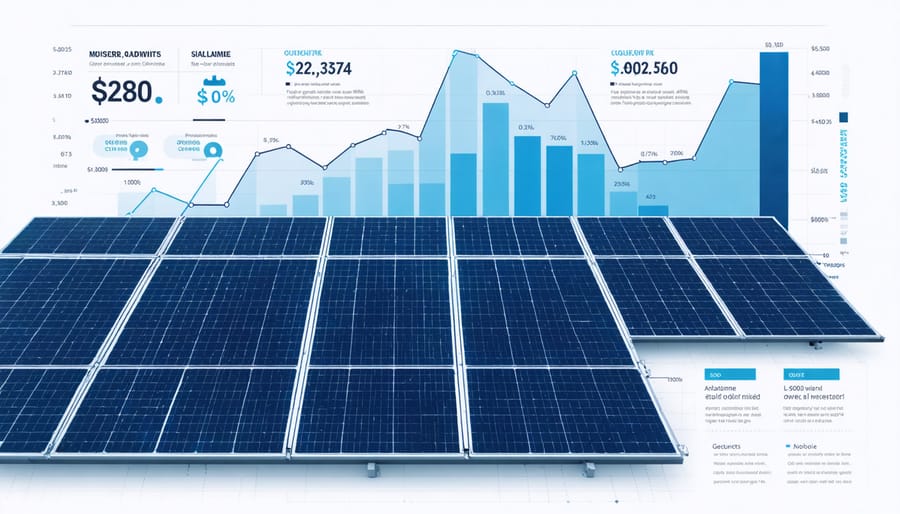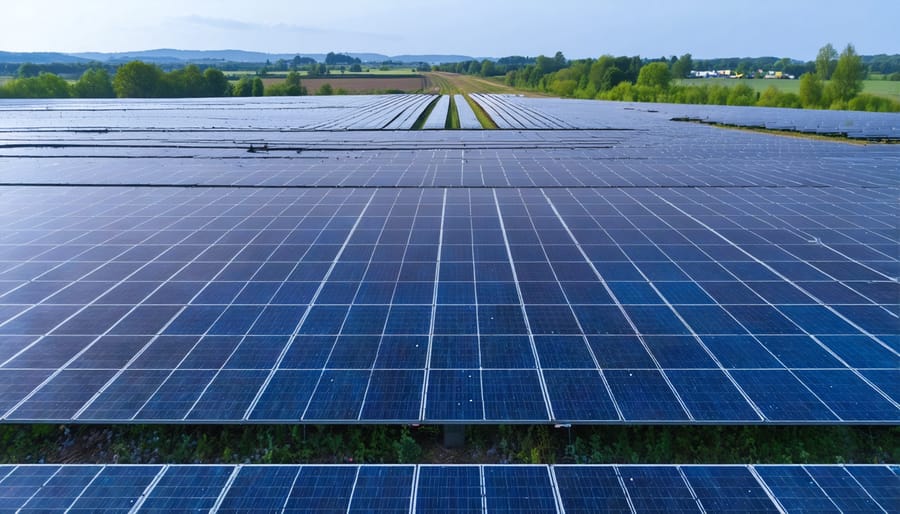Renewable project finance stands at the forefront of clean energy’s explosive growth, with global investment returns reaching unprecedented levels. Modern financing structures now enable projects ranging from utility-scale solar farms to community wind installations to move from concept to completion with remarkable efficiency. By combining traditional debt instruments with innovative green bonds and sustainable investment vehicles, developers are unlocking capital at historically competitive rates while meeting intensifying demand for clean energy assets.
The convergence of declining technology costs, sophisticated financial instruments, and heightened environmental priorities has transformed renewable project finance from a specialized niche into a mainstream investment category. Institutional investors, private equity firms, and traditional lenders are actively competing to fund well-structured renewable energy projects, creating a dynamic marketplace that rewards thorough preparation and strategic financial planning. This evolution in project finance has become a crucial catalyst in accelerating the global transition to sustainable energy infrastructure, while delivering attractive returns for stakeholders across the investment spectrum.
The Evolution of Solar Project Finance

Traditional vs. Modern Financing Approaches
The landscape of renewable project financing has evolved significantly over the past decade. Traditional financing approaches typically relied on straightforward bank loans, corporate financing, and government grants, with lenders focusing primarily on the project developer’s credit history and balance sheet strength. These conventional methods often presented barriers for smaller developers and innovative projects due to strict collateral requirements and lengthy approval processes.
Modern financing approaches have introduced more flexible and accessible options. Project developers can now leverage green bonds, power purchase agreements (PPAs), and innovative crowdfunding platforms. Asset-backed securitization has emerged as a powerful tool, allowing developers to bundle multiple renewable projects into marketable securities. Yieldcos have also gained prominence, providing investors with stable returns while enabling developers to recycle capital into new projects.
The shift toward modern financing solutions has democratized access to capital, reduced dependency on traditional banking institutions, and accelerated project deployment timelines. These innovative mechanisms often offer better risk distribution and can accommodate various project scales, from utility-size installations to community solar initiatives. This evolution has been crucial in driving down the cost of renewable energy development and expanding market participation.
Key Market Drivers
Several key factors are driving innovation in renewable project finance, reshaping how solar installations are funded globally. The rapid technological advancement in solar equipment, coupled with decreasing installation costs, has created new opportunities for innovative financing structures. This evolution is particularly evident in emerging solar markets, where alternative funding mechanisms are gaining traction.
Government policies and incentives continue to play a crucial role, with feed-in tariffs, tax credits, and renewable portfolio standards creating stable investment environments. The growing corporate commitment to sustainability and ESG goals has also sparked increased interest in power purchase agreements (PPAs) and green bonds.
Digital transformation is another significant driver, enabling new financing models through blockchain technology and crowdfunding platforms. These innovations make renewable projects more accessible to diverse investors while improving transparency and reducing transaction costs.
The maturation of energy storage solutions has enhanced project bankability, addressing intermittency concerns and creating additional revenue streams through grid services. This technological advancement, combined with sophisticated risk assessment tools, has attracted institutional investors seeking stable, long-term returns.
Innovative Financing Models Reshaping Solar Investment
Green Bonds and Solar Securities
Green bonds and solar securities represent innovative debt financing mechanisms that have revolutionized renewable energy project funding. These instruments allow investors to participate in sustainable energy development while earning reliable returns, making them increasingly popular in global markets.
Green bonds, specifically labeled for environmental projects, have experienced remarkable growth, with the solar sector accounting for approximately 25% of all green bond issuances in recent years. These bonds typically offer competitive yields while providing investors with the assurance that their capital supports verified sustainable projects.
A notable example is the 2022 California Solar Initiative, which raised $750 million through green bonds with a 3.5% yield, enabling the development of 500MW of solar capacity across multiple facilities. This successful implementation demonstrated how green bonds can effectively bridge the gap between institutional investors and large-scale solar projects.
Solar securities, including solar asset-backed securities (ABS), have emerged as another vital funding tool. These securities package multiple solar installations or power purchase agreements into tradable financial instruments, providing investors with steady cash flows backed by solar assets.
For project developers, these instruments offer several advantages:
– Lower cost of capital compared to traditional financing
– Longer repayment terms aligned with project lifecycles
– Enhanced project credibility through third-party verification
– Access to a broader pool of investors
The market for these instruments continues to mature, with standardized documentation and reporting frameworks making them increasingly attractive to institutional investors seeking sustainable investment opportunities.
Crowdfunding and Community Solar Finance
Crowdfunding and community solar initiatives have emerged as innovative financing solutions that democratize renewable energy investment while enabling broader participation in solar project development. These collective investment models allow multiple stakeholders to pool resources and share both the costs and benefits of solar installations.
Community solar programs typically operate through two primary models: ownership-based and subscription-based. In ownership-based models, investors purchase shares in the solar installation, receiving returns through energy credits or revenue sharing. Subscription models allow participants to purchase electricity from the shared facility at reduced rates without requiring upfront capital investment.
Notable success stories include the Brooklyn Microgrid project, where neighborhood residents invested in local solar installations through blockchain-enabled trading platforms. Similarly, the Massachusetts Solar Loan Program demonstrated how public-private partnerships could facilitate community investment in solar projects while ensuring broader access to clean energy.
For project developers, crowdfunding platforms provide an alternative to traditional financing methods, often with lower transaction costs and faster capital deployment. These platforms have evolved to include sophisticated investment tools, such as solar bonds and revenue-sharing agreements, that cater to different investor risk profiles.
Key benefits of community solar financing include:
– Reduced individual investment requirements
– Broader access to solar energy benefits
– Enhanced community engagement
– Distributed financial risk
– Increased project scalability
When implementing these models, careful consideration must be given to regulatory compliance, investor protection measures, and long-term management structures to ensure sustainable project outcomes.

Power Purchase Agreements 2.0
Modern Power Purchase Agreements have evolved significantly, introducing innovative structures that better address the needs of both renewable energy developers and corporate buyers. Virtual PPAs have gained prominence, allowing organizations to support renewable energy projects without requiring physical delivery of electricity. These financial instruments enable companies to hedge against electricity price volatility while meeting sustainability goals.
Aggregated PPAs represent another advancement, where multiple buyers pool their demand to achieve economies of scale. This model has made renewable energy procurement more accessible to medium-sized businesses that previously lacked the purchasing power for individual agreements. For example, a recent consortium of tech companies successfully negotiated a 300MW solar project in Texas, demonstrating the viability of this approach.
Contract flexibility has also improved with the introduction of volume-firming agreements and proxy generation PPAs. These structures help mitigate weather-related production risks and provide more predictable revenue streams for project developers. Additionally, hybrid PPAs combining multiple renewable sources, such as wind and solar, are emerging to provide more reliable power output and better match consumption patterns.
Environmental attributes have become increasingly sophisticated, with PPAs now incorporating specific provisions for renewable energy certificates (RECs) and carbon offset benefits. This evolution reflects growing corporate emphasis on verifiable environmental impact and regulatory compliance in sustainability reporting.
Risk Management and Financial Innovation

Advanced Risk Assessment Tools
Modern renewable project finance relies heavily on sophisticated risk assessment tools that combine traditional financial metrics with advanced technological capabilities. These tools incorporate artificial intelligence and machine learning algorithms to analyze multiple risk factors simultaneously, providing more accurate project viability assessments.
Predictive analytics platforms now enable investors to model various scenarios, considering factors such as weather patterns, energy demand fluctuations, and supply chain resilience. Monte Carlo simulations have become increasingly popular, offering thousands of potential outcome scenarios to help stakeholders make more informed decisions.
Geographic Information Systems (GIS) integration allows for detailed site-specific risk analysis, considering factors like terrain, local regulations, and grid connectivity. These tools can automatically flag potential challenges and suggest mitigation strategies, significantly reducing the likelihood of unexpected issues during project implementation.
Environmental, Social, and Governance (ESG) risk assessment tools have also evolved, helping projects maintain compliance while maximizing positive community impact. Modern platforms can track and measure ESG metrics in real-time, ensuring projects meet increasingly stringent sustainability requirements.
Financial institutions are now deploying blockchain-based tools for enhanced transparency and risk tracking, allowing stakeholders to monitor project performance and risk factors continuously. This technology provides an immutable record of project milestones and compliance, building investor confidence and streamlining due diligence processes.
Insurance and Hedging Strategies
Insurance and hedging strategies play a crucial role in mitigating risks associated with renewable energy projects. Project developers typically employ a combination of traditional insurance products and innovative financial instruments to protect their investments. Property and casualty insurance covers physical assets against damage from natural disasters, equipment breakdown, and other unforeseen events. Performance ratio insurance safeguards against underperformance of renewable energy systems, particularly important for solar and wind projects where output predictions directly impact revenue projections.
Weather derivatives and production guarantees have emerged as essential hedging tools, particularly for weather-dependent renewable projects. These instruments help stabilize cash flows by compensating for revenue shortfalls during periods of adverse weather conditions. Professional liability insurance protects against design, engineering, and construction errors, while business interruption coverage ensures continued debt service during operational disruptions.
Many project developers also utilize power purchase agreement (PPA) hedging strategies to lock in energy prices and revenue streams. Cross-currency swaps and interest rate hedges protect against market volatility, especially crucial for international projects exposed to multiple currency risks. Environmental attribute trading, such as renewable energy certificates (RECs), provides additional hedging opportunities while potentially creating supplementary revenue streams.
Insurance costs typically represent 1-3% of total project costs but can significantly enhance project bankability and investor confidence. Comprehensive risk management strategies often combine multiple insurance products and hedging instruments, tailored to specific project requirements and regional considerations.
Real-World Success Stories
Several groundbreaking renewable energy projects have demonstrated the effectiveness of innovative financing approaches. The Copenhagen Infrastructure Partners’ 800MW Vineyard Wind project off the coast of Massachusetts exemplifies successful hybrid financing, combining traditional project finance with institutional investment. The project secured $2.3 billion through a mixture of construction loans, tax equity investments, and private placements, enabling the first commercial-scale offshore wind farm in the United States.
In India, the Bhadla Solar Park showcases how public-private partnerships can drive large-scale renewable development. The project utilized a unique financing structure where government guarantees attracted international investors, resulting in record-low tariffs of $0.038 per kWh. This approach has since become a model for developing nations seeking to scale up their renewable infrastructure.
The Australian Clean Energy Finance Corporation’s success with green bonds demonstrates the power of innovative debt instruments. Their 2019 issuance of AUD $100 million in climate bonds funded multiple distributed solar projects across the country, achieving both environmental impact and commercial returns exceeding 7%.
Morocco’s Noor Ouarzazate Solar Complex presents an exemplary case of multilateral financing. The project combined funding from the World Bank, African Development Bank, and European Investment Bank, alongside private capital. This blended finance approach enabled the construction of the world’s largest concentrated solar power plant, providing renewable energy to over 2 million people.
Spain’s Iberdrola utilized sustainable-linked bonds to finance their renewable portfolio expansion. Their €2.5 billion green financing framework incorporated ESG metrics into interest rates, creating additional incentives for meeting sustainability targets. This innovative approach has reduced financing costs while accelerating project development timelines.
These success stories demonstrate how creative financing solutions can overcome traditional barriers to renewable energy development, providing replicable models for future projects worldwide.
Renewable project finance continues to evolve rapidly in response to the shifting global energy landscape, presenting both opportunities and challenges for stakeholders across the industry. The key takeaways from our analysis highlight the growing importance of innovative financing mechanisms, including green bonds, power purchase agreements (PPAs), and hybrid financing models that combine multiple funding sources.
The future outlook for renewable project finance remains exceptionally positive, driven by decreasing technology costs, supportive policy frameworks, and increasing corporate commitment to sustainability goals. We anticipate continued growth in sustainable investment products, enhanced standardization of financing mechanisms, and greater integration of ESG criteria into funding decisions.
Looking ahead, successful renewable energy projects will likely leverage multiple financing sources while maintaining strong risk management practices. The emergence of digital platforms and blockchain technology is expected to streamline project finance processes, making renewable energy investments more accessible to a broader range of investors.
For stakeholders considering renewable energy projects, the key to success lies in understanding available financing options, maintaining strong project fundamentals, and staying informed about emerging trends and opportunities in the market. As the industry matures, we expect to see more standardized financing solutions and improved risk assessment methodologies, making renewable energy projects increasingly attractive to institutional investors and private capital.

